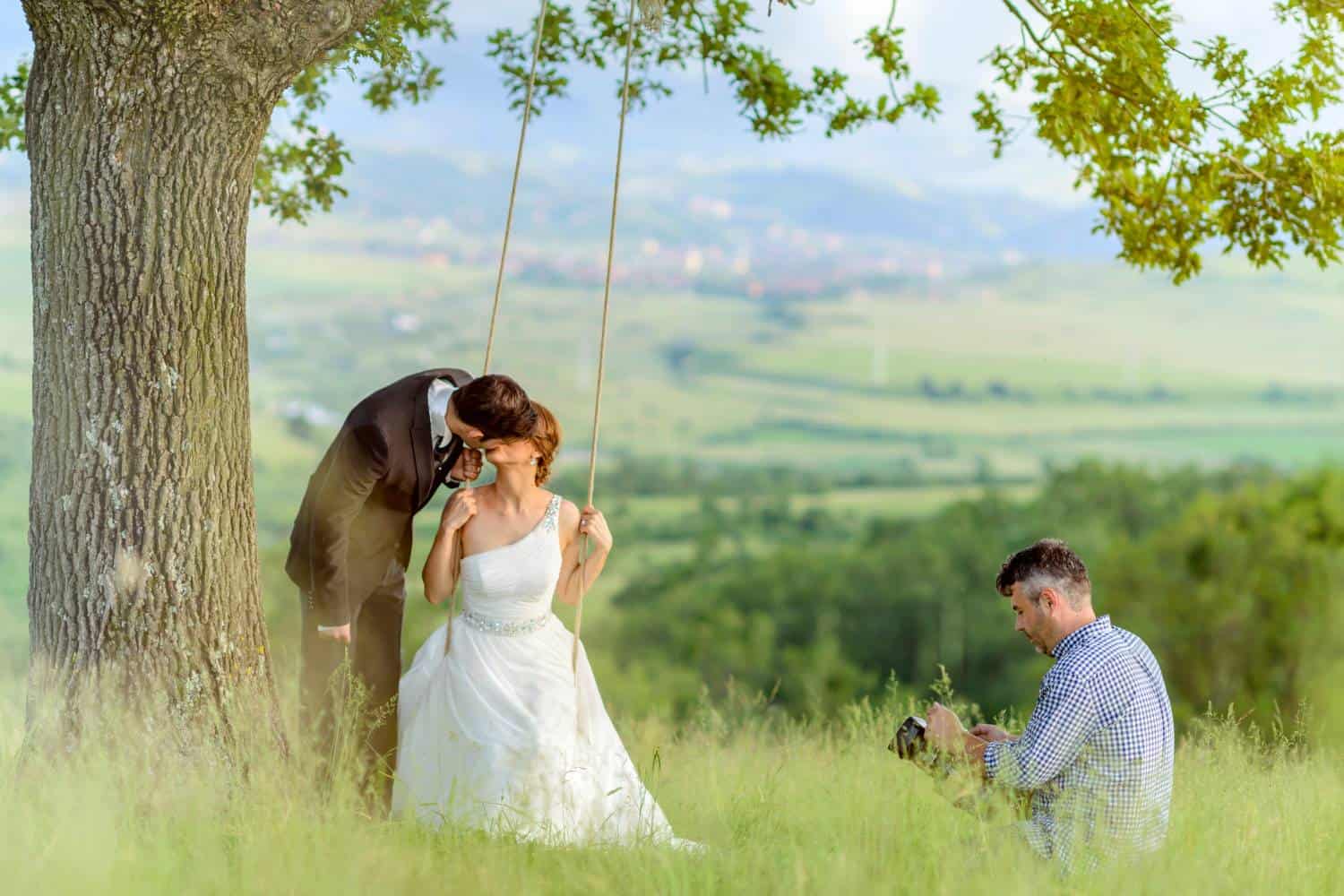Shooting a wedding solo as a photographer can seem overwhelming, but it’s entirely manageable if you plan well and approach the day with confidence.
While it’s common for photographers to have second shooters or assistants, many professionals find themselves working independently at some point in their career.
This guide will walk you through the necessary steps and strategies to help you capture a wedding day on your own successfully, ensuring you don’t miss any important moments.
Let’s Get Straight to the Point
Shooting a wedding by yourself can be challenging, but it’s achievable with the right preparation and confidence.
Key steps include creating a detailed shot list, scouting the venue in advance, managing your time and equipment efficiently, and coordinating with the couple or a designated helper for group photos.
It’s crucial to stay adaptable, trust your skills, and communicate clearly with guests and the wedding planner.
Backup equipment and flexible camera settings are essential, and delivering the final photos promptly after the event ensures client satisfaction.
With thorough planning, solo wedding photography can be a rewarding experience.
1. Plan and Prepare Thoroughly
Create a Shot List
One of the most critical steps to shooting a wedding by yourself is planning your shots in advance.
Weddings are fast-paced, and without a second shooter to cover different angles, it’s essential to know exactly what you need to capture.
Create a detailed shot list of all the essential moments, including:
- Ceremony moments: The bride walking down the aisle, the exchange of vows and rings, the first kiss.
- Couple portraits: Both candid and posed shots of the couple alone.
- Family portraits: Ensure you capture group photos with family members, which are often very important to the couple.
- Reception highlights: Key moments like the first dance, speeches, cake cutting, and the bouquet toss.
Work with the couple to identify any special requests they may have.
For example, they might want a picture of the bride and groom with a specific family member or friend group.
A thorough shot list ensures you don’t miss any key moments and helps you stay focused during the day.
Meet with the Couple
Before the wedding day, meet with the couple to discuss their expectations and any specific shots they want.
This is the time to clarify what’s most important to them and build a strong working relationship. Some couples may have very particular requests, so it’s crucial to get on the same page.
Ask questions such as:
- Are there any specific family members or guests they want featured in the photos?
- Do they have any creative or unusual photo ideas they’d like to try?
- How many formal group photos do they want, and when do they prefer to take them?
This meeting will help you plan your day better and set expectations for both yourself and the couple.
2. Scout the Venue
Visit the Location in Advance
Shooting a wedding at a location you’ve never visited can be stressful, so make sure you scout the venue before the big day.
Visiting the location will allow you to familiarise yourself with the layout, lighting conditions, and any potential obstacles.
You’ll also have the opportunity to pinpoint the best spots for key shots, such as where to position yourself for the ceremony, the best locations for couple portraits, and areas for family photos.
Take the time to check how lighting changes throughout the day at the venue. If you’re shooting an outdoor ceremony in the afternoon, you may have harsh sunlight to deal with.
If you’re shooting indoors, you’ll want to know where the natural light is coming from and how it affects the space.
Knowing the venue well in advance allows you to be more efficient on the wedding day, ensuring you spend less time searching for locations and more time taking great photos.
Prepare for All Lighting Conditions
Weddings can involve a wide range of lighting situations.
The ceremony may take place outdoors in bright sunlight, while the reception could be indoors in low light.
As a solo photographer, you need to be prepared to handle all these conditions smoothly.
Carry lighting equipment like flashes or reflectors, and practice using them in various situations.
During your visit to the venue, take note of where shadows fall, how light enters the space, and how you can use it to your advantage.
If there’s time, take test shots at the venue to check how your settings work in different environments.
3. Manage Your Time and Gear Effectively
Use Quick and Flexible Camera Settings
When shooting alone, you won’t have the luxury of spending too much time adjusting your camera settings between shots.
It’s essential to know your camera well enough to switch settings quickly, especially as the lighting and environment change throughout the day.
Shoot in manual mode when possible to have full control over exposure and lighting.
If you’re moving between indoor and outdoor spaces, set custom functions on your camera to adjust quickly between different lighting situations.
For example, you might have one setting prepared for bright outdoor light and another for dim indoor spaces.
Also, use a fast shutter speed for moving subjects, such as when the bride walks down the aisle or during the first dance. This will help ensure you capture sharp images, even when things are moving quickly.
Bring Backup Equipment
One of the worst situations for a photographer is having a piece of equipment fail on a wedding day.
To avoid disaster, always bring backup gear. Pack a second camera body, several lenses, and extra memory cards and batteries.
Here’s a basic list of equipment you should carry:
- Two camera bodies
- A range of lenses (a wide-angle lens, a standard zoom, and a telephoto lens)
- External flash units for low-light situations
- Extra batteries and memory cards
- A sturdy camera bag to keep everything organised
If you don’t yet own enough gear, consider renting equipment for the wedding.
Renting ensures you have the necessary tools to do the job right, and as you build your business, you can gradually invest in additional gear.
4. Get Help Where You Can
Appoint a Family Member or Friend as Coordinator
Though you’re shooting solo, you don’t have to handle everything on your own. Ask the couple to appoint a reliable family member or friend as a “photo coordinator.”
This person can help gather family members and other guests for group shots and keep people organised.
Having someone assist with wrangling groups allows you to focus on composing the shot rather than searching for people.
This person should be familiar with the key family members and friends to make the process smooth. They can also ensure that people are ready for the photos when it’s time for formal portraits, reducing delays.
Communicate with the Wedding Planner
If the couple has hired a wedding planner, coordinate with them on the wedding day schedule.
The planner can be a valuable ally, helping you stay on track and keeping things moving smoothly.
Ask the planner about the schedule for key events such as the ceremony, cocktail hour, reception, and speeches.
Knowing the timeline will allow you to be in the right place at the right time. If there’s a planner, they can also inform you about any last-minute changes, helping you adapt quickly.
5. Build Confidence as a Solo Photographer
Take Charge and Direct Guests
When you’re the only photographer, you need to take control of the situation. Don’t be shy about giving directions to guests and the wedding party.
Whether you’re organising family photos or asking the couple to pose for portraits, clear communication is key to getting the shots you need.
Politely instruct people on where to stand and how to pose, and make sure you’re assertive enough to gather everyone together when it’s time for group photos.
Weddings can be chaotic, so being confident in your approach will make the process smoother for everyone involved.
Trust Your Abilities
Shooting a wedding by yourself can feel overwhelming, but it’s essential to trust your skills.
You’ve likely spent years honing your craft, and this is an opportunity to showcase what you can do. Keep calm, follow your shot list, and trust that your experience will guide you through the day.
It’s normal to feel pressure when working solo, but remember that you’ve prepared for this.
Believe in your abilities, stay focused, and take it one shot at a time. Your confidence will help you stay composed and capture the best moments.
6. Be Flexible and Adapt to Unexpected Changes
Stay Adaptable Throughout the Day
Weddings rarely go perfectly according to plan. Timelines can shift, the weather might not cooperate, or unexpected events can pop up.
The key to shooting a wedding successfully is adaptability. If the timeline changes, be ready to adjust your plans and capture moments as they happen.
For instance, if rain interrupts an outdoor ceremony, switch to your backup plan and find indoor locations for photos.
If the speeches take longer than expected, adjust your schedule to make sure you still have time for key shots later in the evening. Stay flexible, and don’t let unexpected changes throw you off.
Handle the Social Aspects Professionally
As a wedding photographer, you’ll often be asked to accommodate various requests from guests, such as taking specific photos or including people you may not know.
Be polite and do your best to meet these requests without disrupting your schedule. However, if certain requests are outside of your scope, explain calmly that you have a set plan to follow.
Managing these social interactions professionally will help keep the day running smoothly and ensure that you capture the most important moments for the couple.
7. Post-Wedding Follow-Up
Organise and Back Up Your Photos
Once the wedding is over, immediately back up all your photos.
Losing images from a wedding is devastating, so make sure you store them in multiple places—on external hard drives, cloud storage, and your computer.
Organise the images so that they’re easy to find when you start the editing process.
Deliver the Photos in a Timely Manner
After the wedding, communicate with the couple about the delivery of their photos.
Let them know how long the editing process will take and when they can expect to receive the final images. Stay in touch during this time to manage expectations and ensure they’re happy with your work.
Conclusion
Shooting a wedding by yourself can be challenging, but with thorough preparation, the right equipment, and strong communication, it’s entirely achievable.
By creating a shot list, knowing the venue, managing your time, and trusting your skills, you’ll be able to capture all the essential moments of the big day.
Stay adaptable, work closely with the couple and any coordinators, and approach the day with confidence.
With the right mindset, shooting a wedding solo can be a rewarding experience that helps you grow as a photographer.



